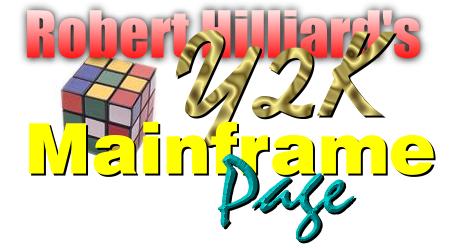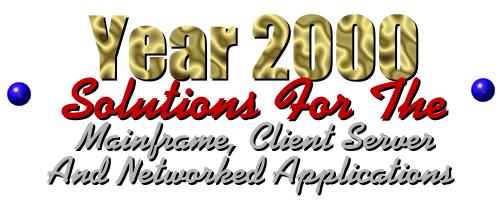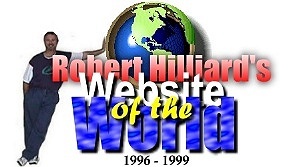If you have a
suggestion or comment,
feel free to send
me e-mail.

Robert Hilliard's Website of the World is featured on such websites as:
ZDNet
Microsoft's MSNBC Technology
miningco.com Orlando, FL.
CMPNet NetGuide
America Online
The Miami Herald
The Dallas Morning News
Peter deJager's Year 2000
BugNet
GeoCities
Massachusetts Institute of Technology
Robert Hilliard's Website of the World has been featured in the following publications:
Web Guide Monthly, (Sept. 1998 Issue)
Rochester Engineer, Rochester Engineering Society, (Oct. 1998)
IFMA Notes, International Facility Management Association, (Sept. 1998)
This website is best experienced with Microsoft Explorer 4.0 (or higher) or Netscape Communicator 4.04 (or higher) at 800X600 display size. Some pages are formatted in frames.
This site

Notice:
The information and material contained on this page are provided "as-is" without warranty of any kind, expressed or implied, including without limitation, any warranty concerning the accuracy, adequacy, or completeness of such information or material or the results to be obtained from using such information or material. Robert E. Hilliard will not be liable for any claims attributable to any errors, omissions, or other inaccuracies in the information or material contained on this page. And in no event shall Robert E. Hilliard be liable for direct, indirect, special, incidental, or consequential damages arising out of the use of such information or material.

About this Website
suggestion or comment,
feel free to send
me e-mail.

ZDNet
Microsoft's MSNBC Technology
miningco.com Orlando, FL.
CMPNet NetGuide
America Online
The Miami Herald
The Dallas Morning News
Peter deJager's Year 2000
BugNet
GeoCities
Massachusetts Institute of Technology
Robert Hilliard's Website of the World has been featured in the following publications:
Web Guide Monthly, (Sept. 1998 Issue)
Rochester Engineer, Rochester Engineering Society, (Oct. 1998)
IFMA Notes, International Facility Management Association, (Sept. 1998)
This website is best experienced with Microsoft Explorer 4.0 (or higher) or Netscape Communicator 4.04 (or higher) at 800X600 display size. Some pages are formatted in frames.
This site


About this Website














The Year 2000 problem is a tough nut to crack at any level, but when it comes to the Mainframe, Client Server and any or all Networked Applications where you have hundreds of communication partners, it becomes a nightmare!
To address these problems, experts working on Year 2000 solutions suggest taking these key steps:
 Initiate a Year 2000 Program - To have solutions in place by 1999, there's not much time left, so , you must identify potential date formatting issues and define a methodology for handling and correcting these issues. Form a committee and brainstorm the issue. Develope your plans to rectify the problem within your system. Most importantly, ask for and receive management's backing!
Initiate a Year 2000 Program - To have solutions in place by 1999, there's not much time left, so , you must identify potential date formatting issues and define a methodology for handling and correcting these issues. Form a committee and brainstorm the issue. Develope your plans to rectify the problem within your system. Most importantly, ask for and receive management's backing!
 Audit Your Systems And Applications - Y2K problems are not limited to the mainframe. Many Unix and PC systems are vulnerable as well. Check all applications that include hard-coded dates. Define interdependencies between systems, including dependencies you have on electronic partners or other information suppliers.
Audit Your Systems And Applications - Y2K problems are not limited to the mainframe. Many Unix and PC systems are vulnerable as well. Check all applications that include hard-coded dates. Define interdependencies between systems, including dependencies you have on electronic partners or other information suppliers. Set Standards - Choose a method for date formatting in all applications. Insist that hardware and software vendors provide a schedule for shipping Year 2000-ready products that fulfill your requirements. Meet with your electronic partners and agree on methods for handling inconsistant date formats.
Set Standards - Choose a method for date formatting in all applications. Insist that hardware and software vendors provide a schedule for shipping Year 2000-ready products that fulfill your requirements. Meet with your electronic partners and agree on methods for handling inconsistant date formats. Perform Triage - Fix the date formats in all of your networked applications. Work with your partners to decide which ones are most important to your business and focus on those first.
Perform Triage - Fix the date formats in all of your networked applications. Work with your partners to decide which ones are most important to your business and focus on those first. Rewrite Code - Find the hard-coded dates and any other date-sensitive programming and rewrite it to fit the standards you set forth.
Rewrite Code - Find the hard-coded dates and any other date-sensitive programming and rewrite it to fit the standards you set forth. Test, Test, Test - The most time-consuming part of solving the problem is testing and debugging newly coded applications. Set up a "Time Machine" or test region and copy in your applications and age your data. Run up the date in your time machine to the year 2000 and run some tests. See what output you get. Check your screens and reports.
Test, Test, Test - The most time-consuming part of solving the problem is testing and debugging newly coded applications. Set up a "Time Machine" or test region and copy in your applications and age your data. Run up the date in your time machine to the year 2000 and run some tests. See what output you get. Check your screens and reports. Set Up A Filtering Mechanism - Regardless of how well you have solved the problem in your own network, data from other organizations may not be consistent with your date-formatting method. A filtering mechanism - sometimes called a "Year 2000 firewall" - can help identify an incompatible date format and delay transmission until it has been converted to the appropriate format.
Set Up A Filtering Mechanism - Regardless of how well you have solved the problem in your own network, data from other organizations may not be consistent with your date-formatting method. A filtering mechanism - sometimes called a "Year 2000 firewall" - can help identify an incompatible date format and delay transmission until it has been converted to the appropriate format.
 Initiate Year 2000-ready Applications - Experts agree that January 1, 1999 is the deadline for cutting over to the repaired applications. Year 2000 problems will begin to affect many applications that project data into the following year.
Initiate Year 2000-ready Applications - Experts agree that January 1, 1999 is the deadline for cutting over to the repaired applications. Year 2000 problems will begin to affect many applications that project data into the following year. Isolate And Troubleshoot Problems - Even with filters, interpreting date information that your network imports could prove difficult. For example, U.S. systems, European systems and ISO standards all define different date formats. In systems that use the same date format, disparate implementations of the "windowing" technique could cause differences in the interpretation of two-digit years.
Isolate And Troubleshoot Problems - Even with filters, interpreting date information that your network imports could prove difficult. For example, U.S. systems, European systems and ISO standards all define different date formats. In systems that use the same date format, disparate implementations of the "windowing" technique could cause differences in the interpretation of two-digit years.
